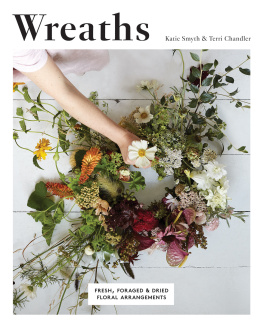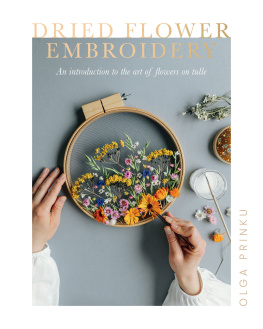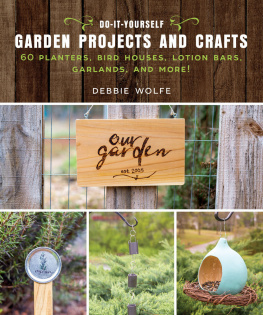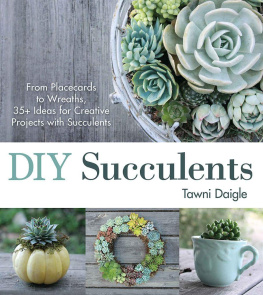BRING
THE
OUTDOORS
IN
Garden Projects for Decorating
and Styling Your Home
SHANE POWERS
WITH JENNIFER CEGIELSKI
Photographs by Gentl & Hyers


Text copyright 2013 by Shane Powers.
Photographs copyright 2013 by Gentl & Hyers / Edge Reps. All rights reserved. No part of this book may be reproduced in any form without written permission from the publisher.
Library of Congress Cataloging-in-Publication Data
ISBN 978-1-4521-2415-5
Designed by Allison Weiner
Chronicle Books LLC
680 Second Street
San Francisco, California 94107
www.chroniclebooks.com

CONTENTS
INTRODUCTION
Ive been fascinated by the natural world for as long as I can remember. I didnt start working with botanicals though until I got a job as a photo stylist for the groundbreaking publication Bloom. The founder, Li Edelkoort, encouraged me to think beyond traditional uses, and focus instead on plants and flowers as more dynamic elements. I began to look at their shapes, colors, and textures with a new perspective.
My work grew to include art directing and styling interiors and still lifes for other magazines such as Vogue Living Australia and Blueprint, and often I brought living things into the mix. A crafter at heart, I honed my skills as an editor of craft assignments (many of which included plants and flowers) for the incredible team at Martha Stewart Living. Eventually, these opportunities led to the development of my indoor garden collection for West Elm. For this collaboration we created simple, contemporary solutions for some of my favorite botanicalsair plants, water plants, cut flowers, and dried elements. Researching and sketching my ideas was a great exercise and the result is a collection of versatility. All of these experiencesstyling, decorating, using plant materials, crafting, developing productshave influenced my approach to the projects found in these pages.
While Ive had the good fortune to work with designers and artisans all over the world, its also true that there is no place like home. For my own home, I look for specimens that common wisdom might say belong outsidemosses, vines, aquatic plants, fernsand bring them in to create moments of natural and unexpected beauty. These displays might happen anywhere indoors, perhaps as a garland of Tillandsia hanging in the corner of a room or in a landscape of ivy cuttings trailing along a shelf, or even in more surprising ways like artwork made using natural elements. For plantings, I fully consider the container and supporting materials along with the main botanical focus so that the entire presentationfrom the hook to the plant to the potworks together to become an incredible object. Sentimental as it sounds, its rewarding to watch something grow and flourish under the care of your own hand in the rooms where you live. And aesthetically speaking, bringing a bit of the natural world indoors introduces unusual colors and textures that enhance our interiors and balance the hard lines of our furnishings.
While trends in flowers and gardening may come and go, the ideas in this book have a timeless appeal to be enjoyed and referenced for years to come. The projects are not gardening projects per se; they are three-dimensional still lifes, miniature worlds designed to enhance your interiors. Some are created with living plants while others use dried materials. The collection includes cut arrangements, potted landscapes, single planters, tableaus of multiples, hanging and water gardens, pressed assemblages, and topiary and terrarium-style projects. At the back, Ive included a list of sources to help get you started with supplies. Most of the projects are made with easy-to-find materials and require minimal maintenance. Even if you dont consider yourself a green thumb you will find something here to create. Remember that the organic process is an irregular one. Your own versions of these projects might not turn out exactly like those in the pictures and they will evolve in their own way, but that is the amazing and wild beauty of nature.
GETTING STARTED
The overall process of bringing the natural world into your home isnt difficultat its core its about choosing the right botanical element to fit with the style of your space and the right location for your plants to flourish. To help you get started, here are some basic care tips to help you determine the best botanicals for your interior, as well as tips for choosing containers and supporting materials, and a list of important tools.
LOCATION, LIGHT & TEMPERATURE First, take a good look around your home and assess what you see. What areas could use a touch of nature? Or, if you are inspired by a particular idea in these pages, have a look around your home to find the best place for it. The small scale of these projects means that theyll work in a variety of locationstabletops, mantels, shelves, windowsills, bookcases, and even hanging from doorknobs or suspended from the ceiling. Think about the rooms where you spend a lot of time, as well as unexpected spots that could benefit from a little romance, like the stairs at an entryway.
When picking a location, consider the light and temperature. You need to be sure that a plant will survive in the spot you choose. Ask yourself: Does this room get enough light? Does it get too much light? Is it too warm, too cool, too dry? Are there air-conditioning or heating vents nearby that could dramatically alter the temperature? Is there a window that will let in too much cold or hot air? Most of the live plants in these projects flourish in partial shade and indirect light indoors, but certain plant groups have very specific needs. Succulents, for example, require full southern sun exposure to thrive, while Tillandsias (air plants) need bright but indirect light. From a climate perspective, ferns and mosses require considerable humidity. The list of plant types below should act as a general guide to the conditions and care required for the plants in these projects. Live plants are usually sold with care instructions; be sure to follow these instructions for optimal results.
PLANT TYPES You may be drawn to a particular project because you find the plant appealing for its color, texture, or shape, whether its something soft and lush like moss or something striking and geometric like succulents. You might choose to work with a single plant or several in a similar variety, or even an assortment of different types of plants. Beyond living plants, you might wish to arrange fresh-cut vines or flowers or create more lasting arrangements from dried flowers and plants or pressed cuttings. Whichever direction you take, I recommend keeping the palette and shapes simple and subtle, and being sure your selection is in keeping with the style and scale of your home. As with many things in design, less is more applies.
AQUATIC PLANTS
A water garden indoors is truly unique and surprising. Placed in a transparent container, the forms of aquatic plants are suspended beneath the surface of the water while light filters gently through the container to cast shadows on the surrounding surfaces. Aquatic plants can be found at aquarium shops: a good shop will be able to direct you to the best kinds of plants for the application you choose. There are a few general categories (including those which float on the waters surface and those with roots below), but the plants Ive used in these projects are known as true aquatics: they live completely submerged underwater. As far as particular varieties, I am partial to the round, disc-like leaves of pennywort, the way baby tears lie low around the bottom rocks, and the way the sculptural leaves of broad leaf swirl upward like green flames. Simple, tall glass vessels are the best containers because they provide a full view of the plant. Some enthusiasts employ air pumps and substrates in tanks for aquatic plants, but Ive had long-lasting success without them following the basic care tips below. Typically the plants are sold with a little basket encasing their roots. This basket anchors easily under a layer of river stones to hold the plant in place in the container, although you may need a mix of both smaller and larger stones for the best results. All-black stones are appealing because they call to mind soil and contrast with the green of the plants well. Be mindful that once the container is filled with plants, stones, and water it will be heavy and difficult to move, so assemble it in its permanent location.












